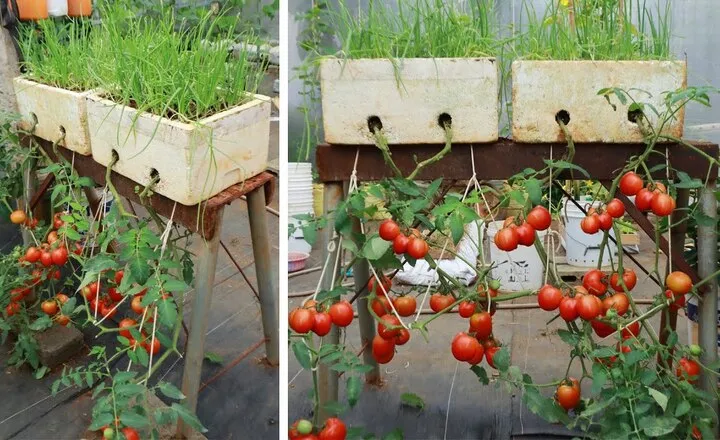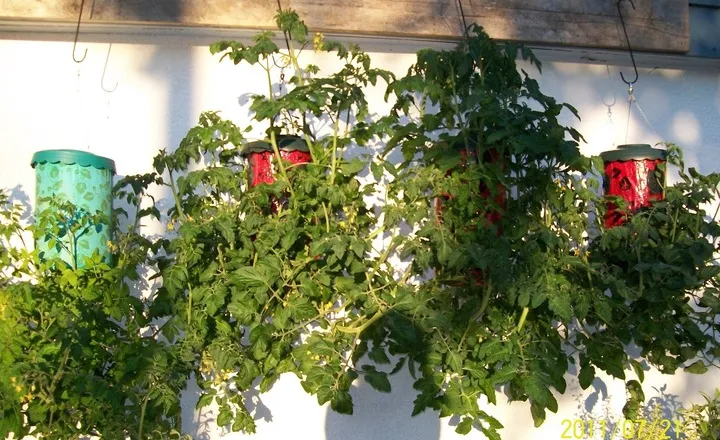Growing tomatoes upside down is a revolutionary gardening technique that not only maximizes space but also offers several unexpected benefits. Not only do these gravity-defying plants thrive with fewer pests since many insects are less likely to invade the higher, suspended fruits—but they also allow for improved air circulation.
This natural ventilation helps reduce the risk of fungal diseases that often plague traditional tomato gardens.
Benefits and disadvantages of growing tomatoes upside down
It offers several unique benefits that can enhance your gardening experience. The most appealing advantage is the aesthetic appeal; these hanging plants can serve as decorative elements on balconies, porches, or in greenhouses where ground space is limited.
This method helps protect tomatoes from pests and diseases commonly found in soil, while allowing for efficient watering directly to the roots. The increased exposure to sunlight and warmth can also lead to faster ripening, potentially yielding fruit up to two weeks earlier than traditional methods.
There are some disadvantages to consider when it. The setup requires sturdy support due to the considerable weight of the plant and container—often around 55 pounds—which can pose challenges in terms of stability and safety.
Planting upside down can be more complicated than conventional gardening techniques, and not every tomato variety is suitable for this method; thicker-stemmed varieties may struggle with the inverted growth pattern.
While upside-down tomato growing has its perks, it demands careful planning and consideration of plant selection for optimal results.
Step by step to growing tomatoes upside down
It is a fun and space-saving gardening technique that can yield delicious results. Start by selecting a deep pot with a sturdy metal handle, as plastic handles may not withstand the weight of the plant.
Ensure you leave ample space around the bucket for sunlight exposure and airflow, which helps prevent fungal diseases. If you’re using an old bucket, consider planting companion herbs like basil in the top section to maximize your garden’s productivity.

Prepare your pot by drilling a hole at the bottom large enough to accommodate the tomato plant’s roots without causing damage. Gently remove the seedling from its original pot and thread the roots through the hole, securing them with a solid cloth or other materials like coconut coir to keep soil in place.
Fill the pot with quality, nutrient-rich soil suitable for vegetables, and consider adding shallow-rooted plants on top. Hang your upside-down garden in a sunny spot and water regularly to ensure healthy growth!
The temperature needed for growing tomatoes upside down
It does indeed require similar temperature conditions to those of traditional planting methods. The minimum temperature for seed germination remains at 50°F, with optimal germination occurring between 72-77°F.
This range is crucial as it ensures that the seeds sprout effectively within the typical timeframe of 8-23 days. The growing environment should maintain temperatures between 64-72°F for optimal growth and fruit development.
This temperature range supports healthy plant metabolism and encourages robust fruit production. Maintaining relative humidity levels between 55-65% will help prevent diseases and promote overall plant health, whether your tomatoes are grown in pots or hanging upside down.
Water for growing tomatoes upside down
It can be a fun and space-saving gardening technique, but it does require careful attention to their water needs.
Tomatoes thrive with moderate moisture levels, and during the critical flowering and fruiting stages, they need constant watering to ensure healthy growth.
When growing upside down, it’s essential to monitor the soil moisture closely since the roots are suspended in a container where drainage and evaporation rates may differ from traditional planting.
To maintain optimal moisture levels for your upside-down tomatoes, consider using a well-draining potting mix that retains some moisture without becoming waterlogged.

Regularly check the soil’s humidity by sticking your finger about an inch into the soil; if it feels dry at that depth, it’s time to water. Incorporating a drip irrigation system or self-watering container can help provide consistent hydration during those crucial growth periods, ensuring your tomatoes receive the right amount of water for robust development.
Soil for growing tomatoes upside down
Selecting the right soil is crucial for success. A light, well-structured potting mix that is rich in organic matter will provide the necessary aeration and drainage for healthy root development.
Avoid heavy clay soils as they can compact easily and hinder root growth, which is especially important when plants are suspended. A blend of peat moss, compost, and perlite or vermiculite can create an ideal environment for your tomatoes to thrive.
Maintaining optimal moisture levels is essential for upside-down tomato plants. Mulching with a white cover material not only helps retain moisture but also reflects sunlight, preventing overheating of the roots.
This technique can enhance overall plant health and yield by ensuring that your tomatoes receive consistent hydration while minimizing the risk of disease from excess moisture on the soil surface. With proper soil selection and care, you can enjoy a bountiful harvest from your upside-down tomato garden.
Conclusion
Growing tomatoes upside down is a creative and effective gardening technique that maximizes space and enhances plant health. This method not only allows for better air circulation but also reduces the risk of soil-borne diseases, resulting in a more fruitful harvest.
With minimal effort and basic materials, even novice gardeners can enjoy the benefits of this innovative approach. As you experiment with upside-down gardening, remember to monitor your plants’ progress and adjust care as needed.
FAQs
How do I get my tomatoes to turn red?
To encourage your tomatoes to turn red, it’s essential to ensure they have the right growing conditions. First, make sure your plants are receiving adequate sunlight—tomatoes thrive in full sun, which means at least 6-8 hours of direct sunlight each day.
Are green tomatoes safe to eat?
Yes, green tomatoes are safe to eat, but there are some important considerations to keep in mind.
